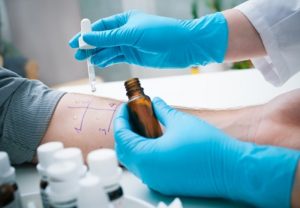What Is The Best Method Of Testing For Allergies?
What Is The Best Method Of Testing For Allergies?
The methods used to testing for allergies vary according to the type of allergic reaction that occurred in that individual. There are predominantly two types of reactions: immediate hypersensitivity (i.e., Type I) and delayed hypersensitivity (i.e., Type IV).
In instances of immediate hypersensitivity reactions, the symptoms usually begin within minutes of exposure to a foreign substance (i.e., allergen, antigen) and progress rapidly. The symptoms may involve the skin, respiratory, gastrointestinal, and/or cardiovascular systems. These types of reactions are mediated by an antibody called immunoglobulin E (i.e., IgE). Allergy testing procedures measure the levels of allergen-specific IgE antibodies. IgE that is specific to foods, venoms, and environmental aeroallergens (i.e., dust mites, molds, pollens, pets, cockroach) are the usual culprits in causing these types of reactions.
There are two common methods used to check for the presence or absence of these antibodies.
- Skin tests (e.g., prick testing, intradermal testing): Skin prick testing is performed by using a small amount of a suspected allergen in liquid form. The allergen is introduced into the outer layers of the skin either with a plastic toothpick-like device or with a tiny needle. In addition to the allergens, positive (i.e., histamine) and negative (i.e., saline) controls are also used for validation of the test results. If the individual has specific IgE to the allergen, it will interact with the allergen and histamine and similar chemicals are released at the site of the test within 10 to 15 minutes. These chemicals cause a “wheal and flare” reaction as evidenced by a small itchy swelling surrounded by an area of redness. These reactions usually subside within an hour. The amount of the IgE antibody and the risk of reactions on natural exposure can be gauged by the size of the swelling. If no swelling and redness is observed at the site, the test is interpreted as negative for that particular allergen. No antihistamine medications should be taken for about 72 hours before the skin test in order to ensure accuracy of the results. Intradermal skin testing is very similar to skin prick testing except with intradermal skin testing, a small amount of the suspected allergen in injected into the top layers of the skin with a tiny needle to create a small bleb or bubble. It is the same procedure that is utilized when performing a PPD test when checking individuals for a history of exposure to tuberculosis, except obviously the substances used with allergy testing are allergens such as foods, venoms, and/or aeroallergens.
- Blood tests: The levels of specific IgE to various allergens can also be measured from a blood sample in a clinical laboratory. The results are usually available after a few days. The blood tests are useful when a person is unable to discontinue antihistamine medications and when there are extensive skin rashes or markings making the skin unsuitable as a marker for reactions.
In cases of delayed hypersensitivity, the symptoms generally begin after days of exposure and progress more slowly. These types of reactions for the most part only involve the skin. They are mediated by types of white blood cells called T-lymphocytes (i.e., T-cells). The offenders in these cases are usually due to metals, adhesives, rubber products, topical antibiotics, topical anesthetics, fragrances, sealants, dermatologic creams, poison ivy, poison oak, poison sumac, flavoring agents, glues, and cosmetics. These reactions occur when the metal, chemical, or other contact allergen comes in physical contact with the skin.
Patch tests are used to detect sensitivity to these contact allergens. The suspected agents are attached to the skin of the individual (i.e., usually on the individual’s back in small square shaped sites) with the help of adhesives and left in place for 48 hours. The test site is examined for reactions after 48 and 72 hours after the initial application. Redness and itching at the site is suggestive of a sensitivity to that specific contact allergen.
The board certified allergy doctors at Black & Kletz Allergy are specialists in diagnosing and treating allergies. We utilize many testing methods when evaluating an individual, depending on the problem and its severity. We treat both adults and children and have offices in Washington, DC, McLean, VA (Tysons Corner, VA), and Manassas, VA. We offer on-site parking at each of our 3 locations and our Washington, DC and McLean, VA offices are Metro accessible. In addition, we offer a free shuttle that runs between our McLean, VA office and the Spring Hill metro station on the silver line. To make an appointment for an allergy or asthma consultation, please call us. If you prefer, you may click Request an Appointment and we will respond to your inquiry within 24 hours by the next business day. The allergists at Black & Kletz Allergy have been practicing for over 50 years and are happy to help you diagnose and treat you allergies so that you can have a better quality of life.













